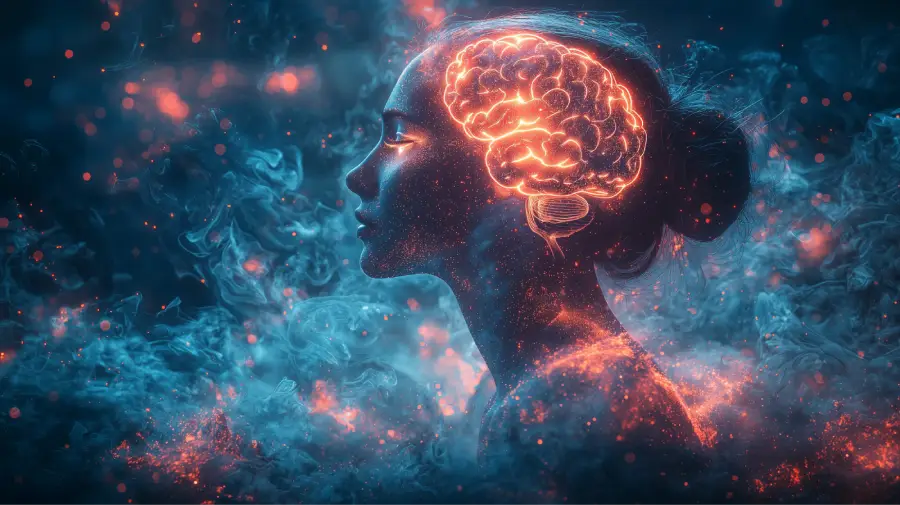ADHD, or Attention-Deficit/Hyperactivity Disorder, is often misunderstood as simply being easily distracted—but it’s much more complex than that.
It’s a condition that influences how you focus, stay organized, and regulate your emotions.
From struggling to stay organized to managing emotions, ADHD can make even routine tasks feel like monumental challenges.
The chaos can feel overwhelming, but it doesn’t have to define you.
Cognitive Behavioral Therapy (CBT) offers a powerful way forward in managing ADHD. Unlike medication, which primarily manages symptoms, CBT focuses on empowering you to change how you think and respond to life’s challenges.
With CBT, you don’t just manage ADHD—you learn how to thrive despite it.
What is ADHD?
ADHD, or Attention-Deficit/Hyperactivity Disorder, is a neurodevelopmental condition that frequently emerges in childhood. This mental disorder also significantly impacts the daily lives of adults.
People with ADHD often experience challenges like difficulty staying organized, managing time effectively, and controlling emotional reactions, which can disrupt their functional outcomes at work, school, or home.
The diagnostic criteria for ADHD include persistent patterns of inattention and/or hyperactivity-impulsivity that interfere with functioning or development. These symptoms are often seen in multiple settings, such as at work and at home, to meet the criteria.
Adults with ADHD often grapple with the added weight of anxiety or depression, amplifying the complexity of their struggles and creating an even greater uphill battle.
CBT can be incredibly helpful in managing ADHD.
Unlike medication, which primarily targets symptoms, behavioral therapy aims to address the underlying thought patterns and habits that contribute to ADHD challenges.
For example, CBT can help you develop skills for prioritizing tasks and managing distractions, ultimately improving functional outcomes.
Similarly, the treatment of adults with ADHD often involves a combination of behavioral therapy and other interventions.
Addressing co-occurring conditions, like anxiety and depression, is crucial to providing effective and holistic ADHD care.
Using strategies tailored to your unique needs, such as cognitive behavioral therapy for ADHD, can help you create lasting changes that improve your quality of life.
Common Misconceptions About ADHD
Many people still don’t fully understand ADHD.
Despite being recognized as a legitimate neurodevelopmental disorder, many still question its validity or downplay its impact.
Let’s clear up some of the most common misconceptions:
1. ADHD is just an excuse for laziness.
Many people believe that ADHD is simply an excuse for poor behavior or laziness.
In reality, ADHD is a complex condition that affects how the brain processes information.
It’s not about being “bad” or “lazy”; it’s about struggling with attention, impulsivity, and organization in ways that can make everyday tasks incredibly challenging.
2. ADHD is only a childhood disorder.
While ADHD is often diagnosed in children, it doesn’t magically disappear with age.
Adults with ADHD can face just as many difficulties—if not more—when it comes to managing their responsibilities and relationships.
Many adults go undiagnosed for years, unaware of how ADHD has influenced their lives.
3. People with ADHD are just disorganized or daydreaming.
Yes, disorganization and inattention are common symptoms, but ADHD goes deeper than this.
It can disrupt emotional regulation, time management, and the ability to focus in critical situations.
It’s not simply “daydreaming”—it’s about struggling to process and respond to the demands of daily life.
4. Medication is the only way to treat ADHD.
While medication can help manage symptoms, it’s not the only viable solution.
Therapy, such as CBT, offers a holistic approach that equips individuals with real-world tools to manage their ADHD and build lasting, positive habits.
ADHD is real, and it’s not something that can be overcome through willpower alone.
The right solution can help you manage ADHD effectively, so you can stop battling your brain and start thriving.
ADHD in Children vs. Adults: How CBT Can Empower You at Every Stage
ADHD looks different depending on your age.
In children, it often manifests as hyperactivity, impulsivity, and classroom disruptions. For adults, ADHD often shows up as time management struggles, disorganization, and difficulty balancing work or relationships.
However, the impact can feel just as intense.
For adults, receiving an ADHD diagnosis can bring a sense of relief and clarity—an explanation for years of struggles.
That’s where Cognitive Behavioral Therapy (CBT) can be a game-changer.
Whether you’ve just received a diagnosis or have been managing ADHD for years, CBT meets you exactly where you are.
It focuses on practical, actionable strategies tailored to the unique demands of adult life.
CBT helps you take control of your ADHD, offering real-world tools to handle work pressure, relationship dynamics, and long-term emotional habits.
With CBT, you don’t just cope with your challenges—you learn to thrive, no matter where you are in your ADHD journey.
Breaking Down ADHD Challenges with CBT

Does CBT work for ADHD? Absolutely.
Cognitive Behavioral Therapy, or CBT, is one of the most effective treatments for managing ADHD.
But why?
At its core, CBT helps you identify unhelpful thought patterns and behaviors—like believing you’ll never be able to focus or getting stuck in cycles of procrastination—and teaches you how to replace them with practical, positive habits.
For example, if you tend to lose track of time, CBT can teach you how to break your day into manageable chunks. If impulsivity gets in the way of your relationships, CBT can help you practice pausing and reflecting before reacting.
While ADHD can make life feel chaotic, CBT works to bring structure and calm to your day-to-day experience.
What makes CBT so effective is that it doesn’t just address residual symptoms; it focuses on skills that can last a lifetime.
CBT vs DBT: What’s the Difference for ADHD?

If you’ve been exploring therapy options for Attention Deficit Hyperactivity Disorder, you’ve probably come across both CBT and DBT. While CBT and DBT might sound similar, they each have unique approaches and strengths.
Understanding the differences can help you decide which might work best for you.
CBT, or Cognitive Behavioral Therapy, focuses on how your thoughts, feelings, and behaviors are connected. With ADHD, this may look like addressing negative thought patterns (e.g., “I’m terrible at staying organized”) and replacing them with positive ones (“I can create systems to stay on track”).
CBT is very structured and goal-oriented, helping you develop practical strategies to manage ADHD symptoms like inattention, procrastination, and impulsivity.
DBT, or Dialectical Behavior Therapy, on the other hand, was originally developed to treat emotional dysregulation. It’s often used to help people manage intense emotions, which can also be a challenge for some individuals with ADHD.
DBT emphasizes four core skills: mindfulness, distress tolerance, emotion regulation, and interpersonal effectiveness. If you struggle with emotional reactivity—like snapping at someone when you’re frustrated—DBT might help you build more control and balance in those moments.
So, which one is right for you?
If your main ADHD challenges revolve around organization, focus, or impulsivity, CBT techniques for ADHD are likely a great fit. However, if you find that intense emotions frequently derail your day, DBT therapy for ADHD might be a better fit. Many therapists combine elements of both approaches to create a personalized plan tailored to your needs.
In short, both CBT and DBT can be powerful tools for managing ADHD.
The secret isn’t in choosing but in blending what works for your unique journey. Your therapist will guide you through this process and help you discover what makes the biggest impact in your day-to-day life.
Signs CBT Might Be Right for You

CBT isn’t for everyone, but it might be the right fit for you if you’re ready to actively work on managing your Attention Deficit Hyperactivity Disorder symptoms.
Here are a few signs it could be a good match:
- You want to learn practical tools: If you’re tired of feeling stuck and want actionable strategies to manage your focus, impulsivity, and organization, CBT offers a hands-on approach.
- You’re open to trying new habits: CBT works best when you’re willing to practice outside of sessions. If you’re ready to experiment with timers, journaling, or mindfulness, it could be a great fit.
- You’ve struggled with negative thoughts about ADHD: If you often feel like ADHD defines you or limits what you can achieve, CBT helps reframe those beliefs and build confidence.
Say you’ve been feeling frustrated because no matter how hard you try, you can’t stay on top of deadlines.
Your CBT therapist can help you use chunking—to break tasks into steps—as well as use the timer method. Applying these tools will help you gain control and overcome your struggles with meeting deadlines.
That’s the power of CBT.
What Happens During a CBT Session for ADHD?
Picture this: You’ve just arrived at your first CBT session.
Your CBT therapist greets you warmly and asks what brings you in. You share how you’ve been struggling with losing focus at work and feeling frustrated at home.
Together, you start unpacking these challenges.
The therapist might ask, “What happens when you lose focus?” You realize it starts with checking your phone, which turns into a 20-minute scroll. Your therapist helps you see this pattern and brainstorms ways to interrupt it. Maybe you set a timer for focused work, paired with short, intentional breaks.
As weeks go on, sessions build on each other.
Let’s say you’ve also been struggling with impulsive spending. Your therapist might introduce a simple strategy: before making a purchase, write down what you’re buying and why. This pause helps you rethink the action and aligns it with your goals.
Each session feels like adding a new tool to your ADHD toolkit, and over time, those tools transform how you handle life’s challenges.
Top Techniques Used in CBT for ADHD
- Cognitive Restructuring
Cognitive restructuring involves identifying negative or unhelpful thoughts or cognitive distortions (like, “I’ll never get this right”) and reframing them into positive ones (“I can try again and improve each time”).It’s a mindset shift that empowers your executive function and builds confidence.
- Chunking
Breaking tasks into smaller, manageable steps. Instead of writing “Finish project” on your to-do list, you might write “Draft outline,” “Write introduction,” and so on.
- Impulse Control Techniques
Impulse control techniques help you pause before acting.For example, counting to five or taking a deep breath when you’re about to interrupt someone can give you a moment to reflect.
- Mindfulness
ADHD often pulls your attention in a hundred directions.Mindfulness practices, like deep breathing or grounding exercises, bring you back to the present and improve focus.
- Journaling
Writing down your thoughts, emotions, and goals can help you track patterns and celebrate progress.
Top Techniques Used in CBT for ADHD

CBT techniques for ADHD are designed to help you manage your thoughts, emotions, and actions more effectively. Here’s a breakdown of some of the most popular ones:
Cognitive Restructuring
Cognitive restructuring involves identifying negative or unhelpful thoughts or cognitive distortions (like, “I’ll never get this right”) and reframing them into positive ones (“I can try again and improve each time”).It’s a mindset shift that empowers your executive function and builds confidence.
Chunking
Breaking tasks into smaller, manageable steps. Instead of writing “Finish project” on your to-do list, you might write “Draft outline,” “Write introduction,” and so on.
Each small win keeps you motivated.
Impulse Control Techniques
Impulse control techniques help you pause before acting.For example, counting to five or taking a deep breath when you’re about to interrupt someone can give you a moment to reflect.
Mindfulness
ADHD often pulls your attention in a hundred directions.Mindfulness practices, like deep breathing or grounding exercises, bring you back to the present and improve focus.
Journaling
Writing down your thoughts, emotions, and goals can help you track patterns and celebrate progress.
It’s a powerful way to reflect and stay on course.
Looking For Therapy?
Start Healing Today.
212-960-8626
What Does Online CBT Look Like for ADHD?
Online CBT for ADHD brings the same practical tools and strategies into the comfort of your home.
Your first online session will typically begin with a conversation about your ADHD challenges and goals.
Through video calls, your therapist will guide you in identifying patterns and experimenting with techniques like breaking tasks into chunks or using mindfulness to stay present.
For example, if you’re struggling with time management, your therapist might suggest using digital tools, such as online timers or apps, to track your progress. If impulsivity is an issue, you might practice pause-and-reflect techniques tailored to your daily routine.
At the end of each session, your therapist will assign practical homework to test out strategies in real life—whether it’s setting a timer during a work task or jotting down spending triggers in a notes app.
Online CBT allows for flexibility, making it easier to integrate therapy into your busy schedule. Plus, it ensures consistent support, no matter where you are. Over time, you’ll develop a toolkit to manage your ADHD and improve your focus, organization, and emotional balance.
It’s therapy, made accessible and effective.
How CBT Addresses Symptoms of ADHD in Everyday Life

CBT is a powerful tool for managing ADHD symptoms like inattention, impulsivity, and hyperactivity, which can disrupt daily life.
It helps break negative thought patterns, such as self-criticism, that add to emotional stress and reinforce bad habits.
With practical strategies, CBT reshapes unhelpful thoughts, builds healthier routines, and empowers you to take control, boosting confidence and stability in your daily life.
A key part of CBT’s approach involves creating a personalized action plan tailored to your specific needs.
This personalized plan focuses on developing essential social skills, managing emotional reactions, and implementing structured techniques to tackle your everyday challenges.
CBT empowers you to master ADHD, creating a path to thrive in therapy and everyday life.
Turning Difficult Times into Growth Opportunities with CBT
ADHD can make life feel chaotic and overwhelming, but it doesn’t have to define your journey. Struggles with poor time management, disorganized routines, or negative thinking patterns can make even small tasks feel insurmountable.
CBT offers a transformative approach to turning challenges into opportunities for growth.
By focusing on actionable tools tailored to your unique needs, CBT empowers you to overcome obstacles like disorganization, impulsivity, and negative thinking patterns.
Whether you’re learning to break tasks into manageable steps, practice mindfulness, or reframe unhelpful thoughts, each CBT session builds your ability to navigate life with confidence and clarity.
ADHD isn’t a roadblock—it’s a challenge you can rise above.
With the right support and strategies, you can turn chaos into growth, transforming struggles into stepping stones toward a more organized, fulfilling life.
CBT isn’t just about managing symptoms—it’s about thriving, no matter where you are in your ADHD journey.
Take the first step today and discover the difference it can make.

